Continuous Real-Time Detection of Serotonin Using an Aptamer-Based Electrochemical Biosensor
Abstract
:1. Introduction
2. Materials and Methods
2.1. Chemical Reagents
2.2. Experimental Apparatus
2.3. Methods
2.3.1. Protocol for XPS Study
2.3.2. Protocol for SPR Study
2.3.3. Electrochemical Sensor Preparation
2.3.4. Aptamer Suspension on the Electrochemical Sensors
2.3.5. Electrochemical Detection for the Static Measurements
2.3.6. Continuous Real-Time Monitoring for Dynamic Measurements
3. Results
3.1. Sensor Electrode Surface Chemistry Characterization
3.1.1. Confirmation of Self-Assembled Monolayer on the Electrode
3.1.2. Thiol Chemisorption on the Gold Surface
3.1.3. Assessment of Aptamer Conformation Change upon Serotonin Binding
3.2. Characterization of the Aptamers Using Surface Plasmon Resonance
3.3. Aptamer Surface Coverage Estimation
3.4. Detection of Serotonin under a Static Environment
3.5. Continuous Detection of Serotonin Using a Microfluidic System
4. Discussion
5. Conclusions
Supplementary Materials
Author Contributions
Funding
Institutional Review Board Statement
Informed Consent Statement
Data Availability Statement
Acknowledgments
Conflicts of Interest
References
- Ramage, A.G. The Role of Central 5-Hydroxytryptamine (5-HT, Serotonin) Receptors in the Control of Micturition. Br. J. Pharmacol. 2006, 147, S120–S131. [Google Scholar] [CrossRef] [PubMed]
- Dăscălescu, D.; Apetrei, C. Development of a Novel Electrochemical Biosensor Based on Organized Mesoporous Carbon and Laccase for the Detection of Serotonin in Food Supplements. Chemosensors 2022, 10, 365. [Google Scholar] [CrossRef]
- Skop, B.P.; Finkelstein, J.A.; Mareth, T.R.; Magoon, M.R.; Brown, T.M. The Serotonin Syndrome Associated with Paroxetine, an over-the-Counter Cold Remedy, and Vascular Disease. Am. J. Emerg. Med. 1994, 12, 642–644. [Google Scholar] [CrossRef] [PubMed]
- Mazure, C.M. Life Stressors as Risk Factors in Depression. Clin. Psychol. Sci. Pr. 1998, 5, 291–313. [Google Scholar] [CrossRef]
- Hammen, C. Stress and Depression. Annu. Rev. Clin. Psychol. 2005, 1, 293–319. [Google Scholar] [CrossRef]
- Antoni, M.H.; Lutgendorf, S.K.; Cole, S.W.; Dhabhar, F.S.; Sephton, S.E.; McDonald, P.G.; Stefanek, M.; Sood, A.K. The Influence of Bio-Behavioural Factors on Tumour Biology: Pathways and Mechanisms. Nat. Rev. Cancer 2006, 6, 240–248. [Google Scholar] [CrossRef]
- Akimova, E.; Lanzenberger, R.; Kasper, S. The Serotonin-1A Receptor in Anxiety Disorders. Biol. Psychiatry 2009, 66, 627–635. [Google Scholar] [CrossRef]
- Graeff, F.G. On Serotonin and Experimental Anxiety. Psychopharmacology 2002, 163, 467–476. [Google Scholar] [CrossRef]
- Naughton, M.; Mulrooney, J.B.; Leonard, B.E. A Review of the Role of Serotonin Receptors in Psychiatric Disorders. Hum. Psychopharmacol. Clin. Exp. 2000, 15, 397–415. [Google Scholar] [CrossRef]
- Stahl, S.M. Mechanism of Action of Serotonin Selective Reuptake Inhibitors: Serotonin Receptors and Pathways Mediate Therapeutic Effects and Side Effects. J. Affect. Disord. 1998, 51, 215–235. [Google Scholar] [CrossRef]
- Isbister, D.G.K.; Bowe, S.J.; Dawson, A.; Whyte, I.M. Relative Toxicity of Selective Serotonin Reuptake Inhibitors (SSRIs) in Overdose. J. Toxicol. Clin. Toxicol. 2004, 42, 277–285. [Google Scholar] [CrossRef] [PubMed]
- Khoshnevisan, K.; Maleki, H.; Honarvarfard, E.; Baharifar, H.; Gholami, M.; Faridbod, F.; Larijani, B.; Faridi Majidi, R.; Khorramizadeh, M.R. Nanomaterial Based Electrochemical Sensing of the Biomarker Serotonin: A Comprehensive Review. Microchim. Acta 2019, 186, 49. [Google Scholar] [CrossRef] [PubMed]
- Cao, Q.; Puthongkham, P.; Venton, B.J. Review: New Insights into Optimizing Chemical and 3D Surface Structures of Carbon Electrodes for Neurotransmitter Detection. Anal. Methods 2019, 11, 247–261. [Google Scholar] [CrossRef]
- Szeitz, A.; Bandiera, S.M. Analysis and Measurement of Serotonin. Biomed. Chromatogr. 2018, 32, e4135. [Google Scholar] [CrossRef] [PubMed]
- Panholzer, T.J.; Beyer, J.; Lichtwald, K. Coupled-Column Liquid Chromatographic Analysis of Catecholamines, Serotonin, and Metabolites in Human Urine. Clin. Chem. 1999, 45, 262–268. [Google Scholar] [CrossRef] [PubMed]
- Jeon, H.-K.; Nohta, H.; Ohkura, Y. High-Performance Liquid Chromatographic Determination of Catecholamines and Their Precursor and Metabolites in Human Urine and Plasma by Postcolumn Derivatization Involving Chemical Oxidation Followed by Fluorescence Reaction. Anal. Biochem. 1992, 200, 332–338. [Google Scholar] [CrossRef]
- Chauveau, J.; Fert, V.; Morel, A.M.; Delaage, M.A. Rapid and Specific Enzyme Immunoassay of Serotonin. Clin. Chem. 1991, 37, 1178–1184. [Google Scholar] [CrossRef]
- Tsunoda, M.; Takezawa, K.; Santa, T.; Imai, K. Simultaneous Automatic Determination of Catecholamines and Their 3-O-Methyl Metabolites in Rat Plasma by High-Performance Liquid Chromatography Using Peroxyoxalate Chemiluminescence Reaction. Anal. Biochem. 1999, 269, 386–392. [Google Scholar] [CrossRef]
- Middelkoop, C.M.; Dekker, G.A.; Kraayenbrink, A.A.; Popp-Snijders, C. Platelet-Poor Plasma Serotonin in Normal and Preeclamptic Pregnancy. Clin. Chem. 1993, 39, 1675–1678. [Google Scholar] [CrossRef]
- Kim, S.K.; Ahmed, M.S.; Jeong, H.; You, J.-M.; Jeon, S. Determination of Serotonin on a Glassy Carbon Electrode Modified by Electropolymerization of Meso-Tetrakis(2-Aminophenyl)Porphyrin and Single Walled Carbon Nanotubes. J. Nanosci. Nanotechnol. 2011, 11, 2407–2412. [Google Scholar] [CrossRef]
- Wei, X.; Wang, F.; Yin, Y.; Liu, Q.; Zou, L.; Ye, B. Selective Detection of Neurotransmitter Serotonin by a Gold Nanoparticle-Modified Glassy Carbon Electrode. Analyst 2010, 135, 2286–2290. [Google Scholar] [CrossRef] [PubMed]
- Liu, M.; Xiang, J.; Zhou, J.; Ding, H. A disposable amperometric sensor for rapid detection of serotonin in the blood and brain of the depressed mice based on Nafion membrane-coated colloidal gold screen-printed electrode. J. Electroanal. Chem. 2010, 640, 1–7. [Google Scholar] [CrossRef]
- Song, J.; Yang, J.; Yang, X. Electrochemical Determination of 5-Hydroxytryptamine Using Mesoporous SiO2 Modified Carbon Paste Electrode. Russ. J. Electrochem. 2009, 45, 1346–1350. [Google Scholar] [CrossRef]
- Li, Y.; Huang, X.; Chen, Y.; Wang, L.; Lin, X. Simultaneous Determination of Dopamine and Serotonin by Use of Covalent Modification of 5-Hydroxytryptophan on Glassy Carbon Electrode. Microchim. Acta 2009, 164, 107–112. [Google Scholar] [CrossRef]
- Wu, G.; Zhang, N.; Matarasso, A.; Heck, I.; Li, H.; Lu, W.; Phaup, J.G.; Schneider, M.J.; Wu, Y.; Weng, Z.; et al. Implantable Aptamer-Graphene Microtransistors for Real-Time Monitoring of Neurochemical Release in Vivo. Nano Lett. 2022, 22, 3668–3677. [Google Scholar] [CrossRef]
- Dankoski, E.; Wightman, R. Monitoring Serotonin Signaling on a Subsecond Time Scale. Front. Integr. Neurosci. 2013, 7, 44. [Google Scholar] [CrossRef]
- Dunham, K.E.; Venton, B.J. Improving Serotonin Fast-Scan Cyclic Voltammetry Detection: New Waveforms to Reduce Electrode Fouling. Analyst 2020, 145, 7437–7446. [Google Scholar] [CrossRef]
- Weaver, C.L.; Li, H.; Luo, X.; Cui, X.T. A Graphene Oxide/Conducting Polymer Nanocomposite for Electrochemical Dopamine Detection: Origin of Improved Sensitivity and Specificity. J. Mater. Chem. B 2014, 2, 5209–5219. [Google Scholar] [CrossRef]
- Hung, P.-S.; Wang, G.-R.; Chung, W.-A.; Chiang, T.-T.; Wu, P.-W. Green Synthesis of Ni@PEDOT and Ni@PEDOT/Au (Core@Shell) Inverse Opals for Simultaneous Detection of Ascorbic Acid, Dopamine, and Uric Acid. Nanomaterials 2020, 10, 1722. [Google Scholar] [CrossRef]
- Zhou, J.; Sheng, M.; Jiang, X.; Wu, G.; Gao, F. Simultaneous Determination of Dopamine, Serotonin and Ascorbic Acid at a Glassy Carbon Electrode Modified with Carbon-Spheres. Sensors 2013, 13, 14029–14040. [Google Scholar] [CrossRef]
- Gupta, V.K.; Shamsadin-Azad, Z.; Cheraghi, S.; Agarwai, S.; Taher, M.A.; Karimi, F. Electrocatalytic Determination of L-Cysteine in the Presence of Tryptophan Using Carbon Paste Electrode Modified with MgO Nanoparticles and Acetylferrocene. Int. J. Electrochem. Sci. 2018, 13, 4309–4318. [Google Scholar] [CrossRef]
- Tasić, Ž.Z.; Mihajlović, M.B.P.; Radovanović, M.B.; Simonović, A.T.; Medić, D.V.; Antonijević, M.M. Electrochemical Determination of L-Tryptophan in Food Samples on Graphite Electrode Prepared from Waste Batteries. Sci. Rep. 2022, 12, 5469. [Google Scholar] [CrossRef] [PubMed]
- Fickbohm, D.J.; Katz, P.S. Paradoxical Actions of the Serotonin Precursor 5-Hydroxytryptophan on the Activity of Identified Serotonergic Neurons in a Simple Motor Circuit. J. Neurosci. 2000, 20, 1622–1634. [Google Scholar] [CrossRef] [PubMed]
- Hashemi, P.; Dankoski, E.C.; Petrovic, J.; Keithley, R.B.; Wightman, R.M. Voltammetric Detection of 5-Hydroxytryptamine Release in the Rat Brain. Anal. Chem. 2009, 81, 9462–9471. [Google Scholar] [CrossRef]
- Swensen, J.S.; Xiao, Y.; Ferguson, B.S.; Lubin, A.A.; Lai, R.Y.; Heeger, A.J.; Plaxco, K.W.; Soh, H.T. Continuous, Real-Time Monitoring of Cocaine in Undiluted Blood Serum via a Microfluidic, Electrochemical Aptamer-Based Sensor. J. Am. Chem. Soc. 2009, 131, 4262–4266. [Google Scholar] [CrossRef]
- Arroyo-Currás, N.; Somerson, J.; Vieira, P.A.; Ploense, K.L.; Kippin, T.E.; Plaxco, K.W. Real-Time Measurement of Small Molecules Directly in Awake, Ambulatory Animals. Proc. Natl. Acad. Sci. USA 2017, 114, 645–650. [Google Scholar] [CrossRef]
- Hu, Z.; Li, Y.; Figueroa-Miranda, G.; Musall, S.; Li, H.; Martínez-Roque, M.A.; Hu, Q.; Feng, L.; Mayer, D.; Offenhäusser, A. Aptamer Based Biosensor Platforms for Neurotransmitters Analysis. TrAC Trends Anal. Chem. 2023, 162, 117021. [Google Scholar] [CrossRef]
- Nakatsuka, N.; Yang, K.-A.; Abendroth, J.M.; Cheung, K.M.; Xu, X.; Yang, H.; Zhao, C.; Zhu, B.; Rim, Y.S.; Yang, Y.; et al. Aptamer–Field-Effect Transistors Overcome Debye Length Limitations for Small-Molecule Sensing. Science 2018, 362, 319–324. [Google Scholar] [CrossRef]
- Nakatsuka, N.; Faillétaz, A.; Eggemann, D.; Forró, C.; Vörös, J.; Momotenko, D. Aptamer Conformational Change Enables Serotonin Biosensing with Nanopipettes. Anal. Chem. 2021, 93, 4033–4041. [Google Scholar] [CrossRef]
- Stuber, A.; Douaki, A.; Hengsteler, J.; Buckingham, D.; Momotenko, D.; Garoli, D.; Nakatsuka, N. Aptamer Conformational Dynamics Modulate Neurotransmitter Sensing in Nanopores. ACS Nano 2023, 17, 19168–19179. [Google Scholar] [CrossRef]
- Rivera-Serrano, N.; Pagan, M.; Colón-Rodríguez, J.; Fuster, C.; Vélez, R.; Almodovar-Faria, J.; Jiménez-Rivera, C.; Cunci, L. Static and Dynamic Measurement of Dopamine Adsorption in Carbon Fiber Microelectrodes Using Electrochemical Impedance Spectroscopy. Anal. Chem. 2018, 90, 2293–2301. [Google Scholar] [CrossRef] [PubMed]
- Fischer, M.J.E. Amine Coupling Through EDC/NHS: A Practical Approach. In Surface Plasmon Resonance: Methods and Protocols; Mol, N.J., Fischer, M.J.E., Eds.; Methods in Molecular Biology; Humana Press: Totowa, NJ, USA, 2010; pp. 55–73. ISBN 978-1-60761-670-2. [Google Scholar]
- Zhang, X.-B.; Kong, R.-M.; Lu, Y. Metal Ion Sensors Based on DNAzymes and Related DNA Molecules. Annu. Rev. Anal. Chem. 2011, 4, 105–128. [Google Scholar] [CrossRef] [PubMed]
- Zhou, W.; Saran, R.; Liu, J. Metal Sensing by DNA. Chem. Rev. 2017, 117, 8272–8325. [Google Scholar] [CrossRef] [PubMed]
- McKeague, M.; McConnell, E.M.; Cruz-Toledo, J.; Bernard, E.D.; Pach, A.; Mastronardi, E.; Zhang, X.; Beking, M.; Francis, T.; Giamberardino, A.; et al. Analysis of In Vitro Aptamer Selection Parameters. J. Mol. Evol. 2015, 81, 150–161. [Google Scholar] [CrossRef] [PubMed]
- Finlayson, K.; Maemoto, T.; Butcher, S.P.; Sharkey, J.; Olverman, H.J. Comparison of Effects of MgCl2 and Gpp(NH)p on Antagonist and Agonist Radioligand Binding to Adenosine A1 Receptors. Acta Pharmacol. Sin. 2003, 24, 729–740. [Google Scholar]
- Moll, J.R.; Acharya, A.; Gal, J.; Mir, A.A.; Vinson, C.; Gal, J. Magnesium Is Required for Specific DNA Binding of the CREB B-ZIP Domain. Nucleic Acids Res. 2002, 30, 1240–1246. [Google Scholar] [CrossRef]
- Venditti, I.; Iucci, G.; Fratoddi, I.; Cipolletti, M.; Montalesi, E.; Marino, M.; Secchi, V.; Battocchio, C. Direct Conjugation of Resveratrol on Hydrophilic Gold Nanoparticles: Structural and Cytotoxic Studies for Biomedical Applications. Nanomaterials 2020, 10, 1898. [Google Scholar] [CrossRef]
- Spampinato, V.; Parracino, M.A.; La Spina, R.; Rossi, F.; Ceccone, G. Surface Analysis of Gold Nanoparticles Functionalized with Thiol-Modified Glucose SAMs for Biosensor Applications. Front. Chem. 2016, 4, 8. [Google Scholar] [CrossRef]
- An, J.E.; Kim, K.H.; Park, S.J.; Seo, S.E.; Kim, J.; Ha, S.; Bae, J.; Kwon, O.S. Wearable Cortisol Aptasensor for Simple and Rapid Real-Time Monitoring. ACS Sens. 2022, 7, 99–108. [Google Scholar] [CrossRef]
- An, K.; Lu, X.; Wang, C.; Qian, J.; Chen, Q.; Hao, N.; Wang, K. Porous Gold Nanocages: High Atom Utilization for Thiolated Aptamer Immobilization to Well Balance the Simplicity, Sensitivity, and Cost of Disposable Aptasensors. Anal. Chem. 2019, 91, 8660–8666. [Google Scholar] [CrossRef]
- Lu, H.B.; Campbell, C.T.; Castner, D.G. Attachment of Functionalized Poly(Ethylene Glycol) Films to Gold Surfaces. Langmuir 2000, 16, 1711–1718. [Google Scholar] [CrossRef]
- Vericat, C.; Vela, M.E.; Benitez, G.A.; Gago, J.A.M.; Torrelles, X.; Salvarezza, R.C. Surface Characterization of Sulfur and Alkanethiol Self-Assembled Monolayers on Au(111). J. Phys. Condens. Matter 2006, 18, R867–R900. [Google Scholar] [CrossRef]
- Lin, K.-C.; Jagannath, B.; Muthukumar, S.; Prasad, S. Sub-Picomolar Label-Free Detection of Thrombin Using Electrochemical Impedance Spectroscopy of Aptamer-Functionalized MoS2. Analyst 2017, 142, 2770–2780. [Google Scholar] [CrossRef] [PubMed]
- Simon, L.; Bognár, Z.; Gyurcsányi, R.E. Finding the Optimal Surface Density of Aptamer Monolayers by SPR Imaging Detection-Based Aptamer Microarrays. Electroanalysis 2020, 32, 851–858. [Google Scholar] [CrossRef]
- Bard, A.J.; Faulkner, L.R.; White, H.S. Electrochemical Methods: Fundamentals and Applications; John Wiley & Sons: Hoboken, NJ, USA, 2022; ISBN 978-1-119-33405-7. [Google Scholar]
- Prinz, H. Hill Coefficients, Dose–Response Curves and Allosteric Mechanisms. J. Chem. Biol. 2010, 3, 37–44. [Google Scholar] [CrossRef]
- Chen, Z.; Wang, Y.; Du, X.; Sun, J.-J.; Yang, S. Temperature-Alternated Electrochemical Aptamer-Based Biosensor for Calibration-Free and Sensitive Molecular Measurements in an Unprocessed Actual Sample. Anal. Chem. 2021, 93, 7843–7850. [Google Scholar] [CrossRef]
- Danaceau, J.P.; Anderson, G.M.; McMahon, W.M.; Crouch, D.J. A Liquid Chromatographic-Tandem Mass Spectrometric Method for the Analysis of Serotonin and Related Indoles in Human Whole Blood. J. Anal. Toxicol. 2003, 27, 440–444. [Google Scholar] [CrossRef]
- Brand, T.; Anderson, G.M. The Measurement of Platelet-Poor Plasma Serotonin: A Systematic Review of Prior Reports and Recommendations for Improved Analysis. Clin. Chem. 2011, 57, 1376–1386. [Google Scholar] [CrossRef]
- Sa, M.; Ying, L.; Tang, A.-G.; Xiao, L.-D.; Ren, Y.-P. Simultaneous Determination of Tyrosine, Tryptophan and 5-Hydroxytryptamine in Serum of MDD Patients by High Performance Liquid Chromatography with Fluorescence Detection. Clin. Chim. Acta 2012, 413, 973–977. [Google Scholar] [CrossRef]
- Hara, K.; Hirowatari, Y.; Shimura, Y.; Takahashi, H. Serotonin Levels in Platelet-Poor Plasma and Whole Blood in People with Type 2 Diabetes with Chronic Kidney Disease. Diabetes Res. Clin. Pr. 2011, 94, 167–171. [Google Scholar] [CrossRef]
- Feldman, J.M. Urinary Serotonin in the Diagnosis of Carcinoid Tumors. Clin. Chem. 1986, 32, 840–844. [Google Scholar] [CrossRef] [PubMed]
- Huang, H.; Chen, Z.; Yan, X. Simultaneous Determination of Serotonin and Creatinine in Urine by Combining Two Ultrasound-Assisted Emulsification Microextractions with on-Column Stacking in Capillary Electrophoresis. J. Sep. Sci. 2012, 35, 436–444. [Google Scholar] [CrossRef] [PubMed]
- Rognum, I.J.; Tran, H.; Haas, E.A.; Hyland, K.; Paterson, D.S.; Haynes, R.L.; Broadbelt, K.G.; Harty, B.J.; Mena, O.; Krous, H.F.; et al. Serotonin Metabolites in the Cerebrospinal Fluid in Sudden Infant Death Syndrome. J. Neuropathol. Exp. Neurol. 2014, 73, 115–122. [Google Scholar] [CrossRef] [PubMed]
- Chávez, J.; Hagen, J.; Kelley-Loughnane, N. Fast and Selective Plasmonic Serotonin Detection with Aptamer-Gold Nanoparticle Conjugates. Sensors 2017, 17, 681. [Google Scholar] [CrossRef] [PubMed]
- Dinarvand, M.; Neubert, E.; Meyer, D.; Selvaggio, G.; Mann, F.A.; Erpenbeck, L.; Kruss, S. Near-Infrared Imaging of Serotonin Release from Cells with Fluorescent Nanosensors. Nano Lett. 2019, 19, 6604–6611. [Google Scholar] [CrossRef]
- Li, R.; Li, X.; Su, L.; Qi, H.; Yue, X.; Qi, H. Label-free Electrochemical Aptasensor for the Determination of Serotonin. Electroanalysis 2021, 34, 1048–1053. [Google Scholar] [CrossRef]
- Raj, M. Graphene/Conducting Polymer Nano-Composite Loaded Screen Printed Carbon Sensor for Simultaneous Determination of Dopamine and 5-Hydroxytryptamine. Sens. Actuators B Chem. 2017, 239, 993–1002. [Google Scholar] [CrossRef]
- Chen, J.; Li, S.; Chen, Y.; Yang, J.; Dong, J.; Lu, X. L-Cysteine-Terminated Triangular Silver Nanoplates/MXene Nanosheets Are Used as Electrochemical Biosensors for Efficiently Detecting 5-Hydroxytryptamine. Anal. Chem. 2021, 93, 16655–16663. [Google Scholar] [CrossRef]
- Jeong, S.; Yang, D.; Beyene, A.G.; Del Bonis-O’Donnell, J.T.; Gest, A.M.M.; Navarro, N.; Sun, X.; Landry, M.P. High-Throughput Evolution of near-Infrared Serotonin Nanosensors. Sci. Adv. 2019, 5, eaay3771. [Google Scholar] [CrossRef]
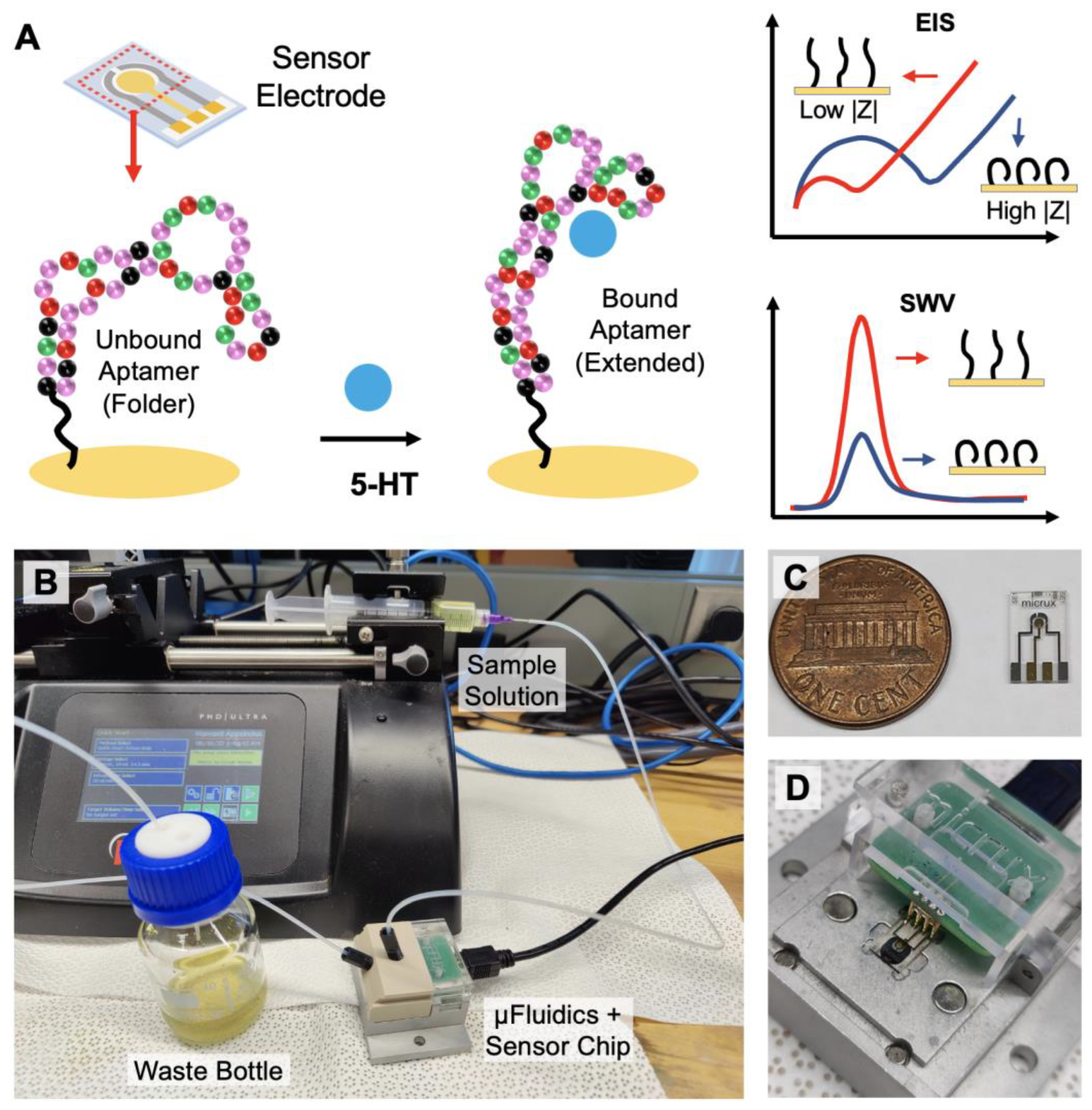
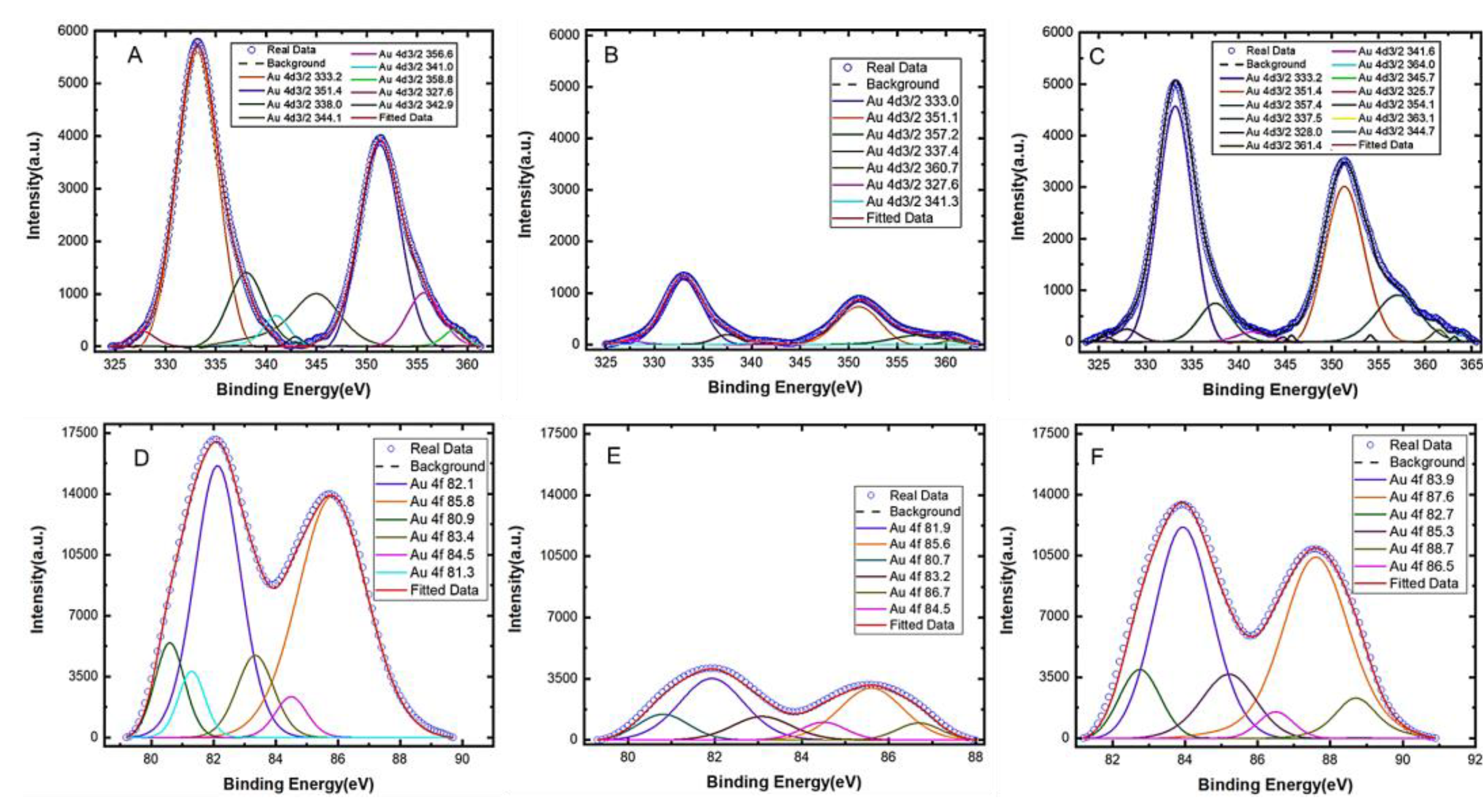
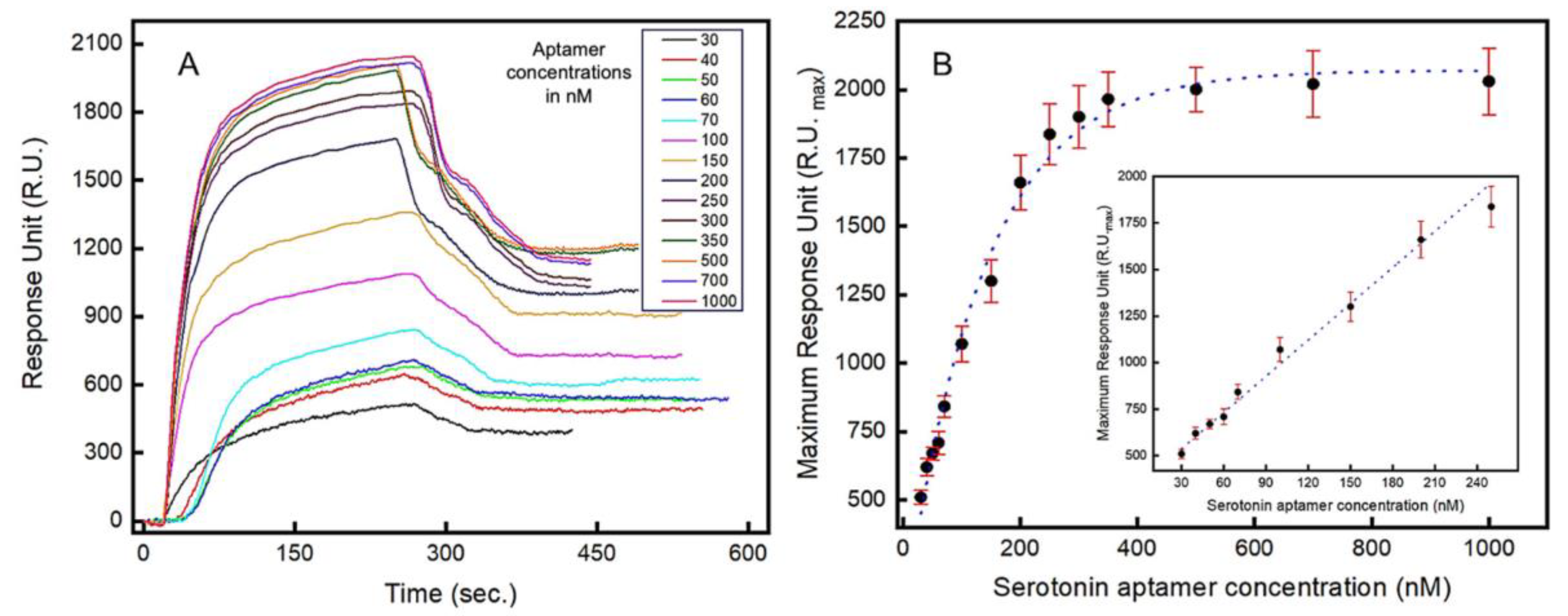

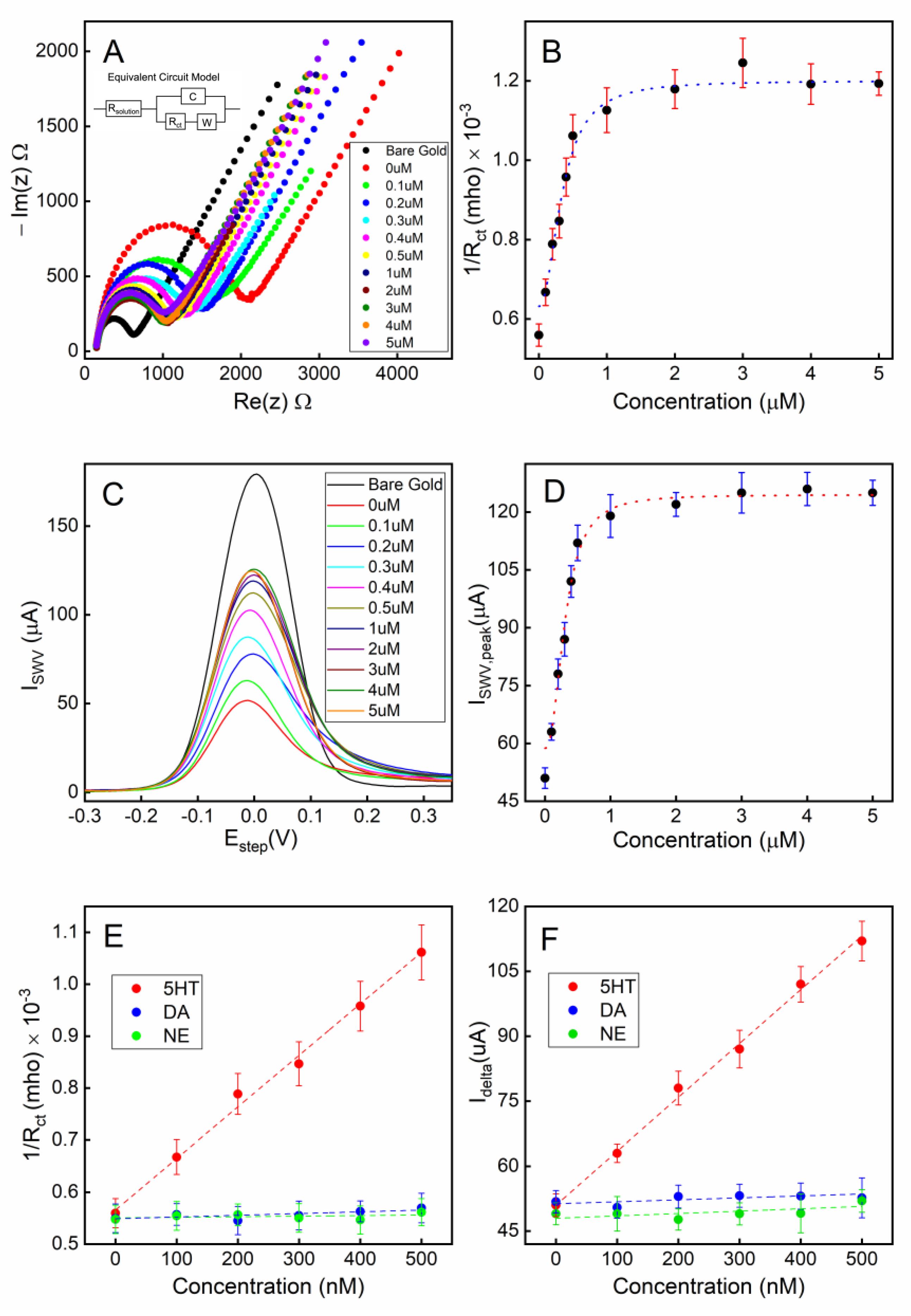
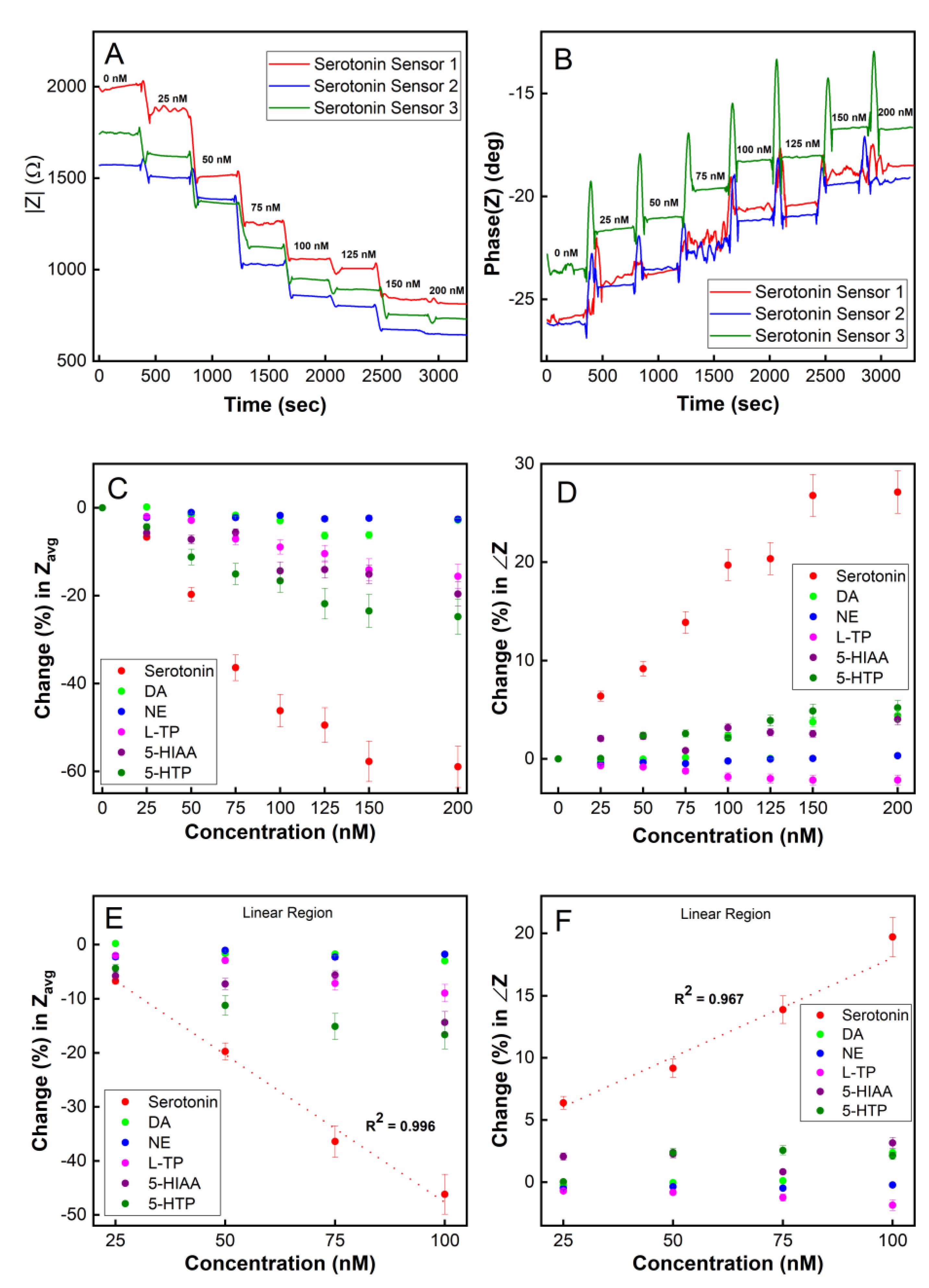
| Sensing Platform | Linear Range | LOD | Reference |
|---|---|---|---|
| Aptamer/AuNPs | 750 nM–2.5 μM | 300 nM | [66] |
| Aptamer/SWCNT | 100 nM–1 μM | - | [67] |
| Aptamer/Gold | 1–100 μM | 300 nM | [68] |
| GR/p-AHNSA/SPCs | 0.05–150 µM | 3 nM | [69] |
| AgNP/L-Cys/MXene | 500 nM–150 μM | 80 nM | [30] |
| ssDNA-SWCNT | 0.1–50 μM | - | [70] |
| GR-FeTSPc | 0.1–100 μM | 20 nM | [71] |
| Aptamer/Nanopipette | 1–100 pM | 1 pM | [39] |
| Aptamer/MCH | 25–100 nM | 5.6 nM | This Work |
Disclaimer/Publisher’s Note: The statements, opinions and data contained in all publications are solely those of the individual author(s) and contributor(s) and not of MDPI and/or the editor(s). MDPI and/or the editor(s) disclaim responsibility for any injury to people or property resulting from any ideas, methods, instructions or products referred to in the content. |
© 2023 by the authors. Licensee MDPI, Basel, Switzerland. This article is an open access article distributed under the terms and conditions of the Creative Commons Attribution (CC BY) license (https://creativecommons.org/licenses/by/4.0/).
Share and Cite
Ahmad, H.M.N.; Andrade, A.; Song, E. Continuous Real-Time Detection of Serotonin Using an Aptamer-Based Electrochemical Biosensor. Biosensors 2023, 13, 983. https://doi.org/10.3390/bios13110983
Ahmad HMN, Andrade A, Song E. Continuous Real-Time Detection of Serotonin Using an Aptamer-Based Electrochemical Biosensor. Biosensors. 2023; 13(11):983. https://doi.org/10.3390/bios13110983
Chicago/Turabian StyleAhmad, Habib M. N., Arturo Andrade, and Edward Song. 2023. "Continuous Real-Time Detection of Serotonin Using an Aptamer-Based Electrochemical Biosensor" Biosensors 13, no. 11: 983. https://doi.org/10.3390/bios13110983
APA StyleAhmad, H. M. N., Andrade, A., & Song, E. (2023). Continuous Real-Time Detection of Serotonin Using an Aptamer-Based Electrochemical Biosensor. Biosensors, 13(11), 983. https://doi.org/10.3390/bios13110983






